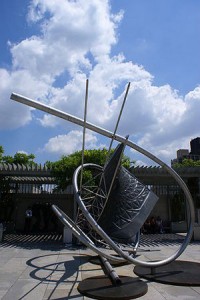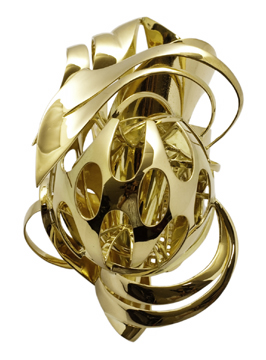Most of us know by now that Dali, Calder, even Picasso designed jewelry at some point. But Yoko Ono, Frank Stella, Damien Hirst, Jeff Koons? Before Picasso to Koons went up at the Museum of Arts and Design last month, I didn’t know they designed jewelry. Most of it is from the collection of guest curator, Diane Venet, the wife of sculptor Bernar Venet, who contributed several pieces.
Much of it is a delight and a surprise. Some is forgettable. Some is the kind of jewelry made by conceptual artists who don’t respect the medium as an end in itself. As Audrey Friedman, owner of Primavera Gallery and collector of jewelry by Dalí and Calder, once told me: “A lot of artists have the idea that because they’re artists, because they’re sculptors, they should do things that are weird, difficult to wear, outsized. I say, if you’re going to make jewelry, make jewelry that can be worn and that doesn’t make the wearer look absurd.”
In other words, some of the jewelry is a failure of the form-follows-function rule. The Frank Stella pieces in the exhibit are an interesting case – a solid effort, recognizably Stella, visually provocative. But do they work as jewelry?

Before Venet showed up to take me through the exhibition yesterday, I was staring at this 11-inch-wide neck piece from different angles, trying to figure out how it was worn. It’s a giant bow with no visible means of securing it to the neck. It almost looks like it was assembled as a choker – that if you pulled those curved wires free on both sides, it might hook behind the neck – but then, at the last minute, the artist turned it into a bow. (It would have made a stunning pendant on a choker wire.) But it sounds like he didn’t approach the project casually – and it doesn’t really look that way either.

Viewers familiar with Stella’s sculpture will recognize the curves formed by the wire from full-size pieces like Memantra in the rooftop garden of the Metropolitan Museum of Art (right).
In the end, maybe he was more concerned with creating a minimized piece of his iconic sculpture than in producing easily-worn jewelry.
Venet says she begged Stella for years to make a piece for her collection, first directly and then through her husband, fellow sculptor and friend of Stella’s. Stella was, flat out, not interested. Then one day when the Venets were visiting, he produced this piece from a drawer and presented it to her as a gift. She was thrilled.
Diane Venet is a beautiful woman with that Parisian instinct that allows her to pull off just about anything and make it look chic. I’m sure the Stella neck piece is no exception. But when she told me she wears it on a black turtleneck, the image that came to mind was the oversized bowtie of a clown. Was Stella being tongue-in-cheek? Yet the central motif, viewed up close, is not at all casually done: a lovely piece of three-dimensional sculpture made sparkly by painting metal with gold.
The bottom line is that when you convince Frank Stella to make a piece of wearable art, you take what you get – and in Venet’s case, you wear it with pride.

A second piece by Stella is a polished gold ring, of which five were produced. I had seen photos but was surprised to see how enormous it was firsthand, more than three inches long and quite bulky.
When I asked Venet if it was wearable, I could tell by her smile that it falls into the category of wearable in the loose sense – as in yes, she manages to lug it through an evening on her finger. And I’m sure it makes an excellent conversation starter.
“You wear nothing else,” she said with her French accent. “Maybe just a simple black dress. And you keep your hand here.” She put her left hand on her right shoulder, and posed for a moment gazing sideways, then laughed.
Obviously, half the fun for Venet is finding a way to wear these pieces – and then wearing them.
Picasso to Koons: The Artist as Jeweler runs through January 8, 2012, at the Museum of Arts and Design, New York City.
Related posts:
Jewelry by Picasso: the secret stash of Dora Maar

